DNA Structure
Learning Objectives
Know the different nitrogen bases and how they pair
Know what a helix is
Know why DNA is called a “double helix”
Vocabulary:
- Deoxyribonucleic Acid (DNA)
- Double Helix
- Helix
- Nitrogen Base
- Base Pair
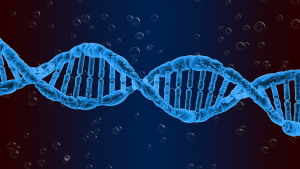
In this video, I’ll be covering some basics about DNA structure. Deoxyribonucleic Acid, or DNA, carries all of the instructions that humans and most other living things need to live, develop, and reproduce. DNA is made up of molecules called nucleotides. There are four types of nucleotides in DNA.
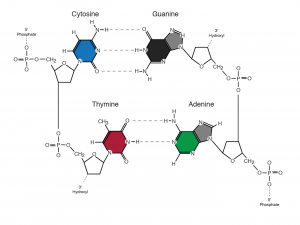
Each nucleotide includes a phosphate group, a sugar molecule, and a Nitrogen Base.
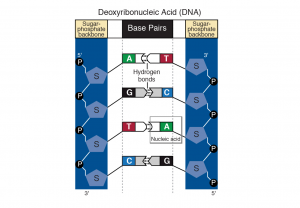
There are four nitrogen bases–A for adenine, C for cytosine,T for thymine, and G for guanine–and they can be thought of as letters in the alphabet. The nucleotides connect to each other in a strand, and the nitrogen bases are in a specific order that forms instructions. These nitrogen bases are able to attach to another nitrogen base to form Base Pairs. Adenine pairs up with thymine, and cytosine pairs up with guanine.
This allows two DNA strands to connect and form something that looks like a ladder. The part that we would think of as ladder rungs are the nitrogen base pairs.
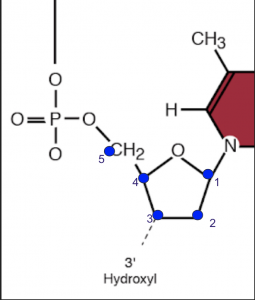
Something you may have noticed is the label of 5’ and 3’ in these diagrams. To put it simply, labeling the ends with 5’ and 3’ indicates the direction of the DNA strand. Every sugar in a nucleotide has 5 carbons. In this diagram they don’t write a C for every Carbon, but I have placed a blue dot to show where these carbons are. The carbons are numbered off. As you can see, the carbon in the bottom left corner is the 3rd carbon, and the carbon that is closest to the top is the 5th carbon. So, 3’ is the bottom, and 5’ is the top. Nucleotides are attached at the 5’ end.
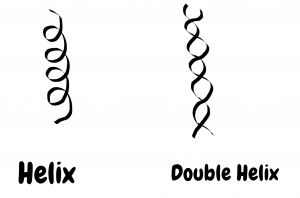
The opposite strand also has 3’ at its bottom and 5’ at the top, but for the strands to fit together, it is flipped upside down. As you can see on the left picture DNA doesn’t exactly look like a straight ladder. To save space, the DNA strand is not straight. It coils and twists so that it can be as small as possible. A Helix describes a corkscrew shape. However, since there are 2 strands that make up DNA, the structure of DNA is described as being a Double Helix, which is depicted on the right.
That’s all for now, thanks!
Figure 1 image credit: by Pixabay (https://pixabay.com/illustrations/dna-genetics-biology-science-3889611/). License: Pixabay License. License Terms: Free for commercial use, no attribution required.
Figure 2/3/4 image credit: by National Human Genome Research Institute (https://www.genome.gov/genetics-glossary/Base-Pair) License: Public Domain
Figure 5 image credit : by Nansea Ji. License: CC BY 4.0

